#southern giant petrel
Explore tagged Tumblr posts
Text

like thats kinda gender
10 notes
·
View notes
Photo

I recently fulfilled a deep desire of mine to go out to sea and pursue the sight of maritime birds. The ocean was beautiful, as soon as my ship left the embrace of False Bay and lost the sight of the Cape of Good Hope we were greeted by flocks of the beautiful Pintado Petrel with wings recalling the pattern of melting alpine snow. We saw the Southern Fulmar, who's ice-colored plumage recalls the Antarctic wildernesses where it rears it's young, the fragile storm-petrel who's wings seem far too small for the unyielding open sea, and the giant-petrel, of whom legends have been told that include the bird's predation on sailors that fall from the decks of their ships. At last, about 30 miles from land we saw a Northern Royal Albatross, a bird with a wingspan nearing 10 feet. Upon sighting the bird I raised my camera to document the near-mystical creature, however, I found myself unable to hold my hands steady in the face of the jarring waves. I was overcome with the torments of Neptune, and at last, while still gripping my camera attempting to continue following the magnificent bird- Gracious reader, I frew up.
548 notes
·
View notes
Text
had a really vivid dream last night where i saw a flock of southern giant petrels..i hope it was a prophetic dream lmao
it's my second tubenose dream i've had: the first was where there were soft-plumaged petrels (that exact species) nesting in my county. for some reason
8 notes
·
View notes
Text
THE FULL FUCKED UP BIRD BRACKET
All birds have been randomized, the seeds mean nothing. Yes pitohui is spelled incorrectly in the bracket image.
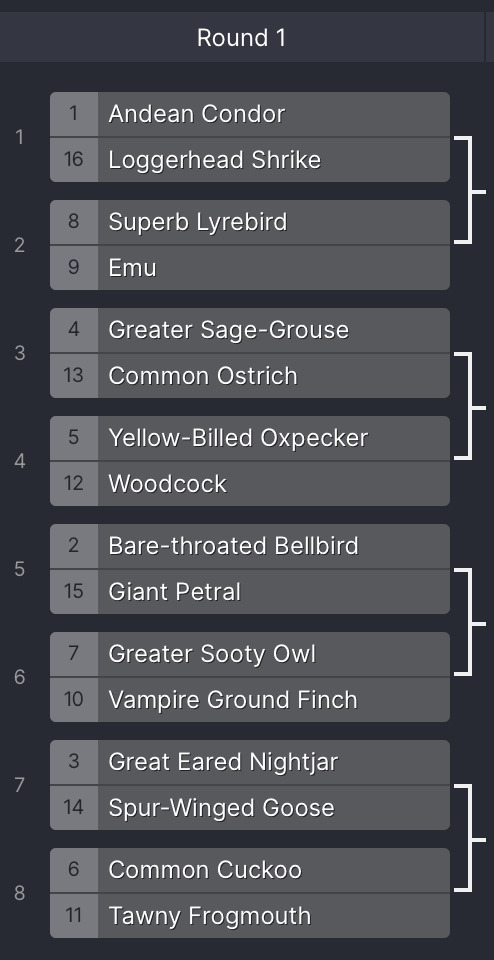
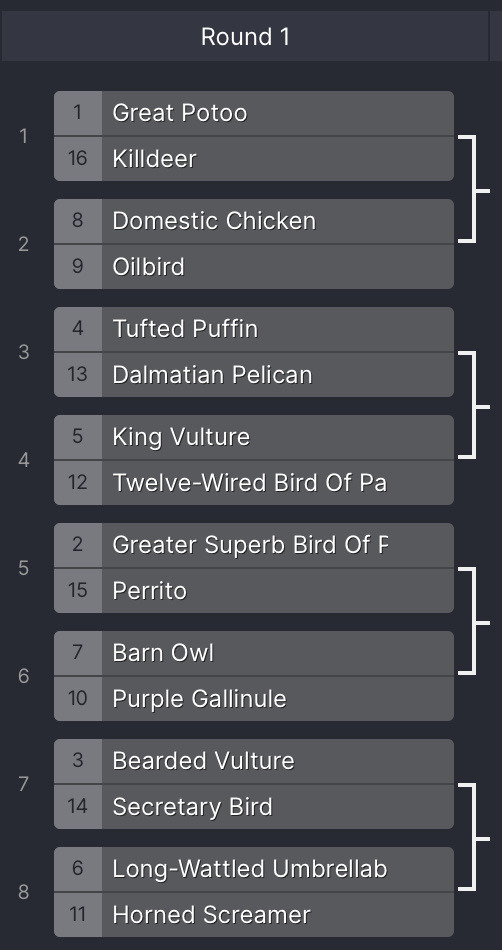

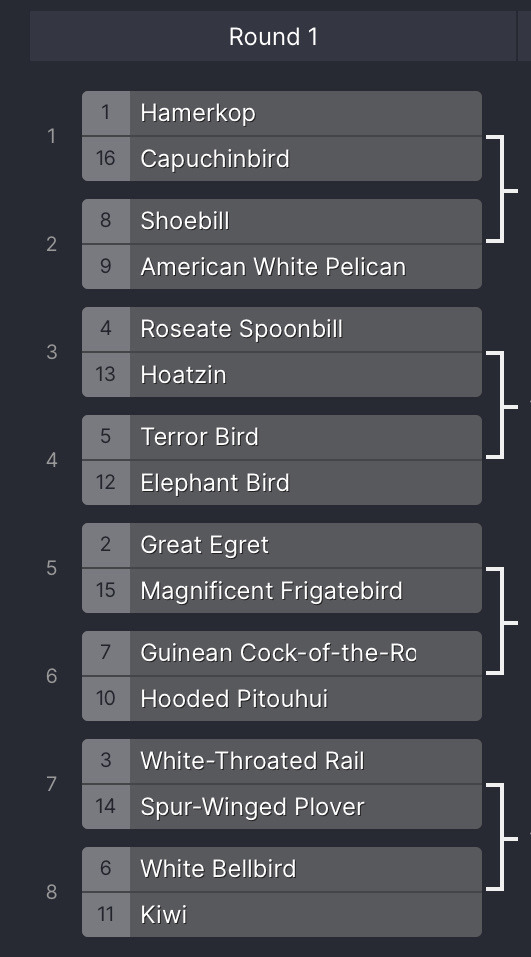
GROUP A
Andean Condor VS Loggerhead Shrike
Superb Lyrebird VS Emu
Greater Sage-Grouse VS Common Ostrich
Yellow-Billed Oxpecker VS American Woodcock
Bare-Throated Bellbird VS Giant Petrel
Greater Sooty Owl VS Vampire Ground Finch
Great Eared Nightjar VS Spur-Winged Goose
Common Cuckoo VS Tawny Frogmouth
GROUP B
Great Potoo VS Killdeer
Domestic Chicken VS Oilbird
Tufted Puffin VS Dalmatian Pelican
King Vulture VS Twelve-Wired Bird Of Paradise
Greater Superb Bird Of Paradise VS Perrito
Barn Owl VS Purple Gallinule
Bearded Vulture VS Secretary Bird
Long Wattled Umbrellabird VS Horned Screamer
GROUP C
Oriental Bay Owl VS Anhinga
Pennant Winged Nightjar VS Snowy Sheathbill
Red-Legged Seriema VS Marabou Stork
Argentavis VS Common Loon
Black Skimmer VS Luzon Bleeding-Heart
Southern Cassowary VS Flamingo (all species)
Green Heron VS Great Hornbill
African Jacana VS California Condor
GROUP D
Hamerkop VS Capuchinbird
Shoebill Stork VS American White Pelican
Roseate Spoonbill VS Hoatzin
Terror Bird VS Elephant Bird
Great Egret VS Magnificent Frigatebird
Guinean Cock-Of-The-Rock VS Hooded Pitohui
White-Throated Rail VS Spur-Winged Plover
White Bellbird VS Kiwi
Polls will be tagged with their BRACKET (example: #bracket a) and #tournament poll
MAY THE WORST BIRD WIN
#information#all of these matchups fucking suck /lovingly#these are literally just all bad bitches being pitted against each other#BRUTAL AS HELLLLLL#mod gf#birdbracket
85 notes
·
View notes
Text

Southern giant petrel racing against cruise ship. @antarctica
#original photography#photographer on tumblr#nature#pws photos worth seeing#water#travel#photograpy#bird#wings#beak#petrel#flying#antarctica#nature photography#animal
5 notes
·
View notes
Text

Raggfong.
I was looking at a mixture of birds for this, Long-tailed Jaeger and White bellied Sea Eagle ended up being the main ones I went with though I did keep the blue/grey I saw in the Southern Giant Petrel and the Magnificent Frigatebird. Also included a Coot with a couple chicks because I didn't realize they were so brightly coloured before and I love them. So, high flying with sharp eyes to hunt, burning off the old and grey in the sun and bathing in a pool, and keeping the bold chick and leaving the timid one to be adopted by the Coot.
9 notes
·
View notes
Note
do any animals ever score below 10/10? lol
There are a couple of animals that are highly invasive (wild boar) or that I refuse to vibe with (southern giant petrel) that are 9/10. Anything ranked from a 10/10-13/10 doesn't really mean anything except for a very obscure rating system I have in my head. Anything 14/10 or higher has a special place in my heart as either one of my favorite animals or one that I have a close connection with.
24 notes
·
View notes
Text

Southern Giant Petrel over the Scotia Sea by Aravind Krishnaswamy
18 notes
·
View notes
Text











Pygoscelis papua, better known as the gentoo penguin, is a species of penguin in the genus pygoscelis which is native to the waters of the southern, south atlantic, and south pacific oceans with notable colonies occurring on the Falkland Islands, South Georgia and the South Sandwich Islands and Kerguelen Islands, Macquarie Island, Heard Islands, Crozet Islands, the South Shetland Islands, and the Antarctic Peninsula. Gentoos mainly feed upon crustaceans, such as krill, squat lobsters, and shrimp but are also known to eat a variety of fish, squid, and octopi. Gentoo penguins are themselves preyed upon by sea lions, leopard seals, orcas, skuas, and giant petrels. Reaching some 28 to 35 inches (70 to 90cms) tall and 9 to 19lbs (4.5 to 8.5kgs) in weight, gentoos are the third largest species of penguin after the emperor penguin and the king penguin. They are the fastest swimming of all birds reaching up to 22 mph (36 kmh). These birds sport a white stripe extending like a bonnet across the top of its head, pale pink feet, and a bright orange-red bill. There tail is also remarkably long, the largest amongst penguins. Gentoo penguins typically mate for life, breeding in large colonies which gather in areas free from ice. Pairs build circular nests made of stones, the smoother the better. These stones are jealously guarded and highly prized, so much so that penguins often trade stones with each other often in exchange for food or sexual favors. Once the nests are build, two eggs are typically laid and incubated in shifts by both parents for 34 to 36 days until hatching. The young then remain in the nests for around 30 days before joining other chicks in the colony and forming crèches. The chicks moult into subadult plumage and go out to sea at around 80 to 100 days. Under ideal conditions a gentoo penguin may live up to 20 years.
#pleistocene pride#pleistocene#pliestocene pride#pliestocene#cenozoic#ice age#stone age#bird#dinosaur#penguin#gentoo#gentoo penguin#antarctica
4 notes
·
View notes
Text
"Antarctic Terror"
2022
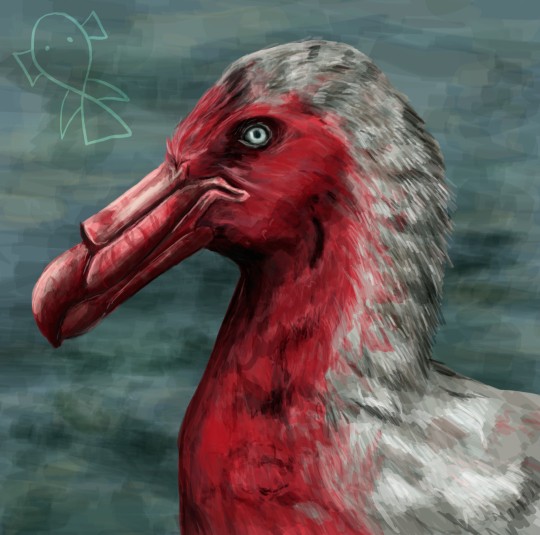
Southern Giant Petrel (Macronectes giganteus)
A very bloody Giant Petrel. One of the most intimidating birds in the world, I think.
#giant petrel#procellariiformes#birds#animals#animal art#wildlife#wildlife art#photoshop#art#artists on tumblr#mexican artist#autistic artist#dartxo
2 notes
·
View notes
Text
to me this post is about the southern giant petrel aka stinkpot
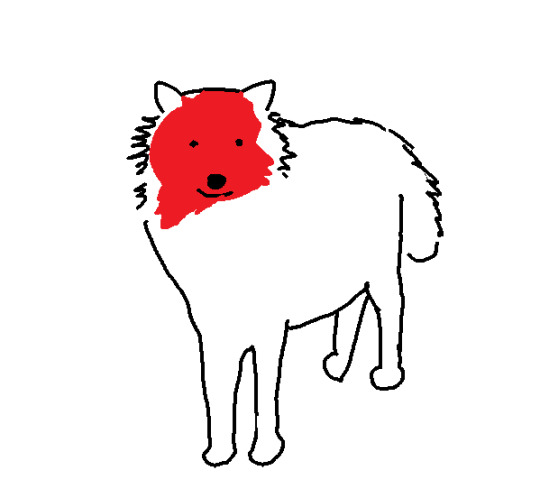
i like the genre of animal photos where you can tell they just dipped their face into a carcass and they dont even care (artistic interpretation)
76K notes
·
View notes
Text
Discovering Tasmania's Unique Wildlife: A Haven for Biodiversity
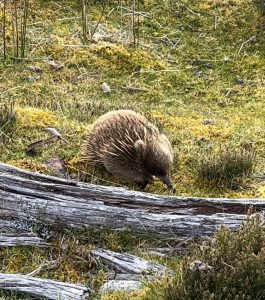
Tasmania, Australia’s island state, is a treasure trove of diverse and unique wildlife. Isolated from the mainland for thousands of years, Tasmania boasts a rich ecosystem filled with endemic species, fascinating habitats, and thriving biodiversity. This makes it a paradise for nature enthusiasts and Wildlife in Tasmania conservationists alike.
Endemic Wildlife
Tasmania is home to several species found nowhere else on Earth. The iconic Tasmanian devil stands out as the most famous. This small, carnivorous marsupial is known for its distinctive screech and powerful bite. Although its population has faced significant threats from Devil Facial Tumor Disease (DFTD), conservation efforts are ongoing to protect and rehabilitate this unique animal.
Another remarkable species is the Eastern quoll, a nocturnal marsupial with spotted fur. Once extinct on the Australian mainland, it thrives in Tasmania’s relatively predator-free environment. The Tasmanian pademelon, a small, wallaby-like marsupial, also calls the island home, adding to its list of endemic mammals.
Birdlife
Tasmania’s bird population is equally remarkable. The island hosts 12 endemic bird species, including the strikingly beautiful green rosella and the Forty-spotted pardalote, one of Australia’s rarest birds. Coastal areas provide sanctuary for seabirds like albatrosses and petrels, while wetlands support migratory shorebirds.
The endangered orange-bellied parrot, one of the world’s rarest parrot species, breeds exclusively in Tasmania’s remote southwest. Efforts to conserve this critically endangered species include habitat protection and breeding programs.
Marine and Aquatic Life
Tasmania’s waters are teeming with marine life. The southern coastline’s kelp forests serve as vital habitats for species such as seahorses, lobsters, and abalone. The Tasmanian coastline is also a prime spot for observing seals, dolphins, and migrating whales, including humpback and southern right whales.
Freshwater ecosystems, including rivers and lakes, are home to the unique Tasmanian giant freshwater crayfish, the world’s largest freshwater invertebrate. Trout fishing is also popular, attracting anglers from around the globe.
Threats to Wildlife
Despite its abundance, Tasmania’s wildlife faces challenges. Habitat destruction, invasive species, and climate change pose significant threats. Feral cats and foxes, introduced to the island, prey on native species, while deforestation reduces critical habitats for many animals.
Conservation programs and national parks play a crucial role in mitigating these threats. Over 40% of Tasmania’s land area is protected, providing a haven for wildlife and ensuring the preservation of ecosystems.
Ecotourism and Wildlife Experiences
Tasmania’s dedication to conservation makes it a top destination for ecotourism. Visitors can explore places like Cradle Mountain-Lake St Clair National Park and Freycinet National Park, offering opportunities to observe wildlife in their natural habitats. Guided tours and wildlife sanctuaries provide ethical encounters with species such as wombats, echidnas, and platypuses.
Conclusion
Tasmania’s wildlife is a testament to the island’s ecological richness and resilience. From endemic marsupials to rare birds and marine wonders, the diversity is both awe-inspiring and fragile. Conservation efforts and sustainable tourism are essential to preserving this natural heritage, ensuring future generations can marvel at Tasmania’s unique biodiversity.
For more details, visit us:
Wineglass Bay and Freycinet Tour
Tasmania Tours
Wildlife hiking wilderness nature tour tasmania
0 notes
Text
A Dream Come True: A Mother-Daughter Voyage to Antarctica
By Ellen Massey

The poles have always fascinated me: the harsh climate, the icy seascapes, the extremes of light and dark, the unique wildlife, and the human history of exploration and the struggle for survival. Antarctica was the first of the polar regions to captivate me. When I was about nine years old, a brochure landed in my family's mailbox advertising a trip to Antarctica. I don't know why we got this ad, but there it was, and I couldn't stop staring at the photographs of penguins and icebergs and stupendous mountains. I was only nine years old, and had never traveled outside North America, but I wanted more than anything to go to Antarctica.

Of course it was way outside my family's budget, but my fascination with the poles stuck with me. Twenty years later, I made a phenomenal sailing voyage to the Arctic, aboard a small and rather rudimentary sloop I had bought, but even that – with the midnight sun, the gray whales, and the sea ice – didn't quench my desire for more time in the polar regions.
Little did I know that my mother had been similarly captivated by that brochure. My mother is my kindred spirit in adventure: before I was born she cross-country skied across the Sierra Nevada range, and throughout my childhood she never let motherhood preclude adventure. So I can't say I was that surprised when she told me that she wanted to go to Antarctica for her 80th birthday. And so, off we went.
Part of me had always envisioned sailing to Antarctica myself, with maybe just one other person, aboard the same small sloop on which I had sailed to the Arctic. But not even that kind of epic adventure could be more memorable and special than going with my mother, on her 80th birthday, to the place both of us had dreamed of for decades.

And it was everything we dreamed of. Jagged, glaciated peaks soaring out of the cold, very blue ocean. Fantastically shaped icebergs reflected in the mirror calm of the dawn. A snow petrel gliding through the silence of softly falling snow. Penguins feeding their young in huge colonies along the shore. The raucous calls of the penguins and the haunting song of a leopard seal. The calving face of the largest glaciers I'd ever seen, and tabular icebergs miles long and many meters tall.


My mom and I boarded the National Geographic vessel in Ushuaia, the town on the southern edge of Tierra del Fuego. Our crossing of the Drake Passage southbound was perfect: sunshine on moderate seas and a light quartering tailwind. We spent the days at sea watching Wandering albatross and Giant Southern petrels wing across the swell, and listening to the superb National Geographic guides give lectures on the ecology, geology, wildlife, and human history of the Antarctic.

Our first stop once we reached Antarctic waters was in the South Shetland Islands where Gentoo penguins waddled along the shore and the more adventuresome Chinstrap penguins climbed steep slopes to reach their colonies on rocky outcrops high above the ocean. As we steamed south that evening, we were treated to a lingering sunset of subtle rose and yellow, glinting off the icy peaks and bathing the wispy cirrus clouds and gently rippled water. Despite the cold, Mom and I stood at the rail for hours, watching the setting sun illuminate this place we'd dreamt of for so long.



Our ship then ventured where few Antarctic itineraries go: to the Weddell Sea, famous for trapping, crushing, and sinking Sir Ernest Shackleton's ship Endurance. Thanks to the great skill and experience of our Ukrainian captain and the Norwegian ice-pilot of the ship, we made a rare circumnavigation of James Ross Island, picking our way carefully among new and old sea-ice, glacial icebergs, and the giant tabular bergs that break off the great ice shelves. At the most southern end of our venture into the Weddell Sea, the head guide woke the whole ship over the intercom at 3:45AM, announcing that the bridge crew had spotted emperor penguins. Emperor penguins are extremely rare to see on a trip to Antarctica. In the summer they are feeding offshore, and in the winter they are well back from the ice edge, huddled together waiting for their eggs to hatch. The iconic penguin of the Antarctic is, therefore, almost guaranteed not to be seen by most visitors. So this was an incredibly exciting moment. My mom and I dressed fast and rushed up on deck, into the bitingly cold pre-dawn air. Almost everyone on the ship had roused themselves to see the emperors and yet the ship was almost entirely silent as we all looked out at a large ice floe on which the two emperors stood. The pearly light, the perfect stillness of the calm morning, and the ice floes and encircling mountains, and most of all this rare wildlife sighting had sent a reverent hush through guests and crew alike.

The calm persisted throughout the day, and so we were treated to a day of kayaking. My intrepid mother adores kayaking; she and a friend of hers would go sea-kayaking several times a week for all the years she lived in Maine. So the chance to kayak on Antarctic waters was a dream come true. The two of us shared a kayak and were able to get up close to the ice floes, examining the deep blue and green colors, the patterns like Venetian glass, and the occasional Weddell seal drawn up on the ice to sun himself.


Of course we took the opportunity of the calm and sunny day to do the polar plunge, jumping into the below-freezing seawater, icebergs all around us. And the ship raised anchor and steamed west for the west coast of the Antarctic peninsula. There we watched humpback and minke whales surface before enormous glaciers, traversed the fabled LeMaire Channel at dawn, and hiked through softly falling snow to a cairn atop an island where a French expedition overwintered in 1909. And then on our last evening among the bergs and peaks, we were treated to yet another subtle and exquisite sunset, beneath which a pod of orcas played, together with a pod of humpbacks, another rare and beautiful occurrence.

All too soon it was time to leave this spectacular, magical land behind. Our ship pointed her bow north into one of the fabled Southern Ocean gales, and for two days bucked aside the monstrous waves that can build in the Drake Passage, the body of water south of Cape Horn. As I stood on the bridge watching the waves sweep over the bow and even hit the windows of the bridge over 15 feet up, I imagined the terror of being in such a storm in my little sailboat. I knew it well, from having rounded the Cape of Good Hope in similar conditions, and I was grateful that I was not the one responsible for this ship this time. Instead I could retire to the dining room with my mother, and recap our favorite moments together watching penguins, kayaking, polar plunging after the kayaking, and gazing at the peaks and glaciers of this fragile, iconic, and forever captivating continent. How happy we both were to have been able to realize our common dream together.
1 note
·
View note
Text
Sunday, March 3










We had a second full day at sea today, and I thought I would throw in some random pictures that have mostly come from my real camera. It has been mostly foggy, windy, and quite rolling since we left South Georgia, and we haven't seen a lot of birds. We did see these Hourglass Dolphins yesterday which were a special treat. We could tell they were trying to race us and get to our bow, but we were moving too fast at that moment. Shortly afterwards we saw these King penguins "saluting" us. Actually, they have blood vessels near the surface on their flippers, and use that to regulate their body temperature, usually trying to get rid of heat. We've seen them standing on shore with their flippers out, cooling off, but this was the first time I've seen this in the water. They generate a lot of heat when they "porpoise" through the water, and then need to cool down. Although the air temperature was a little warmer than the sea, we had 25 knot winds, which cool things down considerably.
The coat of arms was taken from a slide presentation and is the official coat of arms for South Georgia. The Fur Seal and Macaroni Penguin are self-explanatory, but the deer on top needs a little explanation. During the whaling station era (which lasted from about 1904-1966), most of the whaling stations were Norwegian owned and run. Someone decided that hunting reindeer during their off hours would be a great activity and also provide a source of fresh meat. From a small imported herd of 18 animals, and a couple of other later introductions, the herd was at 6700 when it was decided to eliminate non-native species in 2010. Being ruminants, the reindeer ate vegetation used by other species for nesting and food, and out-competed the local fauna. The two herds were eliminated between 2013 and 2015. But since the official coat of arms dates from the declaration of a sovereign state in 1985, the reindeer live forever on it.
Other pictures I've included are a Black-browed Albatross chick, a Rockhopper Penguin, a King Penguin, and a Southern Giant-petrel. The lone penguin on the ice floe is a Gentoo, because they are always the ones to do something different.
Although it is still quite cold outside, we know we are leaving the Southern Ocean and entering the currents of the South Atlantic, and both the sea and the air will be warming quickly. We have two more sea days before Gough Island, which is one of the outlying islands around Tristan da Cunha. We have been kept busy with talks, activities and watching for wildlife in the Bow Lounge, just steps from our cabin. We have also had one time change and will have another before we reach Tristan - the last change until we reach Cape Verde. Not as bad as an Atlantic crossing from the Caribbean. Most of the expedition staff and ship crew have never been to Tristan or Saint Helena, so everyone is excited to see some place new.
0 notes
Text
Days 52-54 - Goodbye Antarctica
Day 52, Monday, 6 February 2023
During the night, the ship took us to Cape Adair – our last point of call on Antarctica. I don’t imagine we will ever get back here, but we can always hope.
Last time we were here, a few passengers landed, before the wind and ice created an emergency and there was quite a dramatic evacuation back to the ship, with the expedition team literally up to their necks in freezing water and frightening surf getting everyone off safely.
This time, things looked much better so we were split into two groups, half to land while the other half zodiac-cruised – and then we all changed places. We were in the second group to land and as we cruised in the zodiac, we saw some really rough sea and moving ice and I couldn’t imagine how we could possibly land – but once we returned to the landing place, we were beautifully sheltered and made a very comfortable landing.
The Borchgrevink huts from the very first overwintering expedition were close by but rather than line up to go inside (only three people and a guide allowed in at any time), we walked quite a long way to a small Southern Giant Petrel colony. It had several young birds as well as at least four of the less-common white morph birds. We returned to the huts where the queue was now much shorter and we went into the dark interior and took a few photographs before returning to the ship.
We were soon waving goodbye to Antarctica and sailing almost due north to the Balleny islands. When we originally booked this trip, we were supposed to visit Macquarie Island but shortly before we left home, they decided to go to the bleak and dismal Ballenys instead. Disappointing and as it happened, a really bad decision.
Great news! I now have my visa to allow us to go to Chile as planned. All we have to hope now is that the political unrest in Peru settles so as not to jeopardise our insurance policy for that part of the trip. And talking about future travel, we had a discussion with Ponant’s on-board travel consultant and after conferring with a few other people (including our wonderful financial advisor) we have decided to book another voyage in September 2024 – to both the North Poles. It will be on this ship which is an icebreaker and will take us to both the Geographic and Magnetic North Poles. That will be quite different from this trip but it starts from Nome, Alaska, and ends in Longyearbyen in Svalbard. Aha – what to do after that? It includes flights from Seattle to Nome and Longyearbyen to Paris so we will probably tack on something extra at one end or the other.
We had an interesting lecture in the afternoon, given by our knowledgeable geologist. She traced the changes in the three main environmental factors impacting climate change over the past four billion years and finished with some suggestions on how we might help to slow down the current rapid changes.
Day 53, Tuesday, 7 February 2023
We were at sea all day and had a fairly weak lecture about seabirds from the same woman who lectured us about albatrosses a couple of weeks ago – also pretty weak then. Heather then went to another cooking class: this one about making Crème Broulee.
Late in the morning, we were approaching the Balleny Islands that were sadly substituted for Macquarie Island as I mentioned above. We saw a very vague outline of the southernmost island through the fog but the Captain said he was not willing to go closer than a couple of kilometres. (Last time, we passed in a much lesser vessel and an even greater storm, and I reckon we were only 3-400 metres away. After that, we saw nothing.) The Captain made numerous announcements about how clever he was navigating between two of the islands, but we never saw them. The fog was thick and it was snowing heavily. (How come snow falls heavily when they talk about things being as light as a snowflake. One for Aristotle or Euclid I think.) The whole exercise was a total farce. We should have gone to Macquarie but if not, we should have passed close enough to the Ballenys to see something. I really don’t think this wimp of a captain has earned the salary of a cabin boy this trip – yet most people applaud him. Weird!
The snow was heavy because we were moving into a magical storm. At one stage, the Captain announced that the winds were at 74 knots (137 kph) – a force 11 on the 12-point Beaufort Scale according to a short segment we got in the Recap. The guy who gave us this segment has given us some great short pieces before – like the ball and orange explanation of the seasons, and one about the time zones. He doesn’t seem to have a lot of polish, but he was a sea captain on numerous big ships for many years and has an immense amount of scientific knowledge. He is also a really nice guy.
The storm was great – still not huge waves – I estimate it at about four to five metres – but the wind was fantastic and we had several hours of driving snow that replenished (three or four times over) the snow that had almost melted from the last wonderful storm. We were in positive temperatures early in the morning (first time for almost 3 weeks at plus 0.3 degrees) but by mid-morning, we were back to minus 4.5. It was a very exciting storm and I really loved watching it.
We crossed the Antarctic Circle back into the temperate zone during the early afternoon, but what was raging all around us belied the fact. The wind abated somewhat around dinner time and although there was a bit of rocking and rolling, sleep came easily for most people, and I don’t think anyone was too seasick. Most are wearing patches, but I think/hope I now have my sea legs. (That is sea legs, not seal eggs!)
In the evening, we had a preview of the Ship’s Cruise movie – an hour-long compilation of videos created by the official photographer that he will sell to anyone stupid to pay 150 euros for a DVD at the end of the cruise. I thought his effort was really poor with whole days and several of the most important activities omitted entirely – to make space for politically correct comments and career protection snippets, many featuring his boss, the Captain. We were told that the rules he had to comply with prevented him showing any recognisable passengers’ faces but close to half of us (but not us) were easily recognised. All up – and maybe I am being overly-critical due to some of the disappointments over the past few days – I reckon the whole production was a bit amateurish – good use of technology, but poor use of his subject matter or creativity.
We then had another quiz and our team and another one tied for first. They decided to have a tiebreaker and the other team won – I can’t even recall what that question was. But we should have won outright due to a disputed answer during the quiz. The question was ‘What city has the highest Greek population after Athens and Thessalonica?’ As Melbournians, we answered ‘Melbourne’, of course – and nobody else got that. But the quizmaster said the answer was Chicago. Mr Google agreed with us, as did a few other references people found – and none of the others guessed Chicago anyway. In the end, the quizmaster voided that question so we tied with the other team and lost the tiebreaker. Bummer – we could have used the luggage tags that were the prize. But just wait until tomorrow when there is real money at stake!
Day 54, Wednesday, 8 February 2023
The storm had passed, but it was still pretty bouncy around the ship. Heather went to a session about possible future Ponant cruises, but I was out on deck looking for birds. There were very few, but I did see a couple of White-headed Shearwaters and a few Broad-billed Prions that I haven’t seen before.
Later in the day, we crossed the Southern Convergence where we expected to see more birds, but 24 hours later still almost nothing. Where are they all? Last time we came through here, there were thousands of them. There were also quite a lot of whales, particularly Humpbacks and we have not seen one since before we left Cape Adair.
There was a lecture in the afternoon by one of the passengers – also a former geology guide on expedition ships. I reckon it was a bit of a joyride for him, an opportunity to promote his company, dressed up in some apparently good science about capturing metals from the seafloor to create hydrogen power and batteries. I was not convinced, but as he said, he had the microphone so he could say what he liked. He did say that as our knowledge of the seabed increased, it may prove him wrong, but if he is right, he really is on a winner for the whole planet.
There was another lecture that started out sounding almost sacrilegious about hunting whales. It was given by our bird expert and traced the history of whaling from antiquity (more than 6500 BC) and built up the story to the 16th and 17th centuries when whale oil became a commercial product and money became the driver for whaling rather than subsistence. He then proceeded to systematically demolish every pro-whaling argument I can ever recall. He started out justifying the legitimacy of whaling in the millennia long past and finished up shredding any possible reason for modern commercial whaling.
Then it was time for the quiz and it was run by the ship’s travel consultant about Ponant cruises and destinations. We were in teams of two and I thought we did reasonably well – and when they announced the winners, we were tied with another couple. Would you believe the prize was a 250-euro voucher for use on a future Ponant cruise – and we have just booked the Two Poles cruise. Rather than have a tiebreaker, they gave both winning teams a voucher. Very generous and we were delighted – so celebrated with yet another of their free champagnes.
0 notes
Photo

Yva Momatiuk and John Eastcott - Southern giant petrel, South Georgia Island
1 note
·
View note